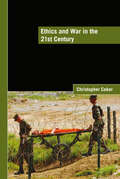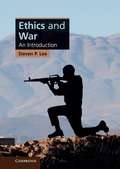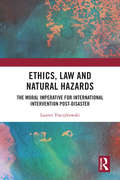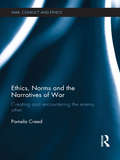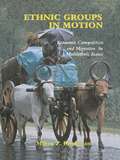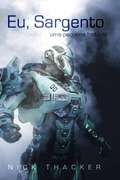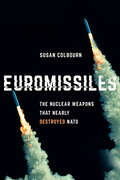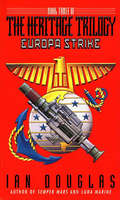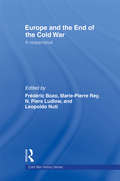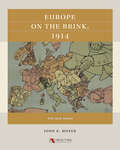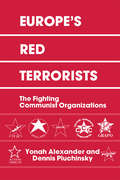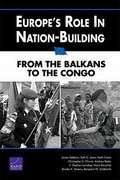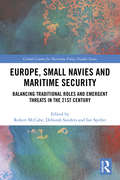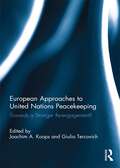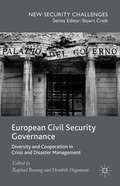- Table View
- List View
Ethics and War in the 21st Century (Lse International Studies Ser.)
by Christopher CokerThis book explores the ethical implications of war in the contemporary world. The author, a leading theorist of warfare, explains why it is of crucial importance that Western countries should continue to apply traditional ethical rules and practices in war, even when engaging with international terrorist groups.The book uses the work of the late Am
Ethics and War: An Introduction
by Steven P. LeeWhat are the ethical principles underpinning the idea of a just war and how should they be adapted to changing social and military circumstances? Steven P. Lee presents the basic principles of just war theory, showing how they evolved historically and how they are applied today in global relations. He examines the role of state sovereignty and individual human rights in the moral foundations of just war theory and discusses a wide range of topics including humanitarian intervention, preventive war, the moral status of civilians and enemy combatants, civil war and terrorism. He shows how just war theory relates to both pacifism and realism. Finally, he considers the future of war and the prospects for its obsolescence. His clear and wide-ranging discussion, richly illustrated with examples, will be invaluable for students and other readers interested in the ethical challenges posed by the changing nature of war.
Ethics and the Laws of War: The Moral Justification of Legal Norms (Contemporary Security Studies)
by Antony LambThis book is an examination of the permissions, prohibitions and obligations found in just war theory, and the moral grounds for laws concerning war. Pronouncing an action or course of actions to be prohibited, permitted or obligatory by just war theory does not thereby establish the moral grounds of that prohibition, permission or obligation; nor does such a pronouncement have sufficient persuasive force to govern actions in the public arena. So what are the moral grounds of laws concerning war, and what ought these laws to be? Adopting the distinction between jus ad bellum and jus in bello, the author argues that rules governing conduct in war can be morally grounded in a form of rule-consequentialism of negative duties. Looking towards the public rules, the book argues for a new interpretation of existing laws, and in some cases the implementation of completely new laws. These include recognising rights of encompassing groups to necessary self-defence; recognising a duty to rescue; and considering all persons neither in uniform nor bearing arms as civilians and therefore fully immune from attack, thus ruling out ‘targeted’ or ‘named’ killings. This book will be of much interest to students of just war theory, ethics of war, international law, peace and conflict studies, and Security Studies/IR in general.
Ethics, Law and Natural Hazards: The Moral Imperative for International Intervention Post-Disaster
by Lauren TraczykowskiThis book argues that the international community has a moral duty to intervene on behalf of a population affected by a natural hazard when their government is either unable or unwilling to provide basic, life-saving assistance. The work draws on law, international relations theory, and political philosophy to articulate that non-response to a natural hazard is unethical. In providing policy suggestions the author articulates what should happen based on an ethical analysis. Readers will thus gain an ethical lens with which to view intervention in the aftermath of a natural hazard. The book encourages readers to consider the nuances of arguments from various disciplines about whether or not intervention is appropriate. Whilst arguing throughout that an intervention policy in response to natural hazards should be developed by the international community, the study also accounts for why intervention should only be used in very limited situations. This interdisciplinary approach makes the book essential reading for researchers, academics and policy-makers working in the areas of international law, humanitarian studies, human rights, international relations and political science.
Ethics, Norms and the Narratives of War: Creating and Encountering the Enemy Other (War, Conflict and Ethics)
by Pamela CreedThis book examines the ethics and values that render a war discourse normative, and features the stories of American soldiers who fought in the Iraq War to show how this narrative can change. The invasion of Iraq, launched in March 2003, was led by the United States under the now discredited claim that Iraq was developing weapons of mass destruction (WMD). However, critical questions concerning what we may be able to learn from this experience remain largely unexplored. The focus of this book, therefore, is on soldiers as systems of war – and the internal battle many of them wage as they live a reality that slowly emerges as inconsistent with familiar beliefs and value commitments. This work offers a reflective study of identity struggle from the perspective of emotional psychology and delves into the ‘narrative field’ of socio-politics. Going beyond the political contestations over the U.S. military intervention in Iraq, the author analyses original research on the evolving beliefs and value-commitments of veterans of the war, exploring their faith in its ‘just cause’ and their personal sense of self and national identity. This book will be of much interest to students of the Iraq War, US foreign policy, military studies, discourse analysis, and IR in general.
Ethics, Technology and the American Way of War: Cruise Missiles and US Security Policy (Contemporary Security Studies)
by Reuben E. Brigety IIA new investigation into how the advent of precision-guided munitions affects the likelihood of US policy makers to use force. As such, this is an inquiry into the impact of ethics, strategy and military technology on the decision calculus of national leaders. Following the first Gulf War in 1991, this new study shows how US Presidents increasingly used stand-off precision guided munitions (or "PGMs", especially the Tomahawk cruise missile) either to influence foreign adversaries to make specific policy choices or to signal displeasure with their actions. Such uses of force are attractive because they can lead to desirable policy outcomes where conventional diplomacy has failed but without the large cost of lives, economic resources, or political capital that result from large-scale military operations. In a post-9/11 world, understanding alternative uses of force under significant policy constraints is still of supreme importance.
Ethnic Germans and National Socialism in Yugoslavia in World War II
by Mirna ZakićThis is an in-depth study of the ethnic German minority in the Serbian Banat (Southeast Europe) and its experiences under German occupation in World War II. Mirna Zakić argues that the Banat Germans exercised great agency within the constraints imposed on them by Nazi ideology, with its expectations that ethnic Germans would collaborate with the invading Nazis. The book examines the incentives that the Nazis offered to collaboration and social dynamics within the Banat German community - between their Nazified leadership and the rank and file - as well as the various and ever-more damning forms collaboration took. The Banat Germans provided administrative and economic aid to the Nazi war effort, and took part in Nazi military operations in Yugoslav lands, the Holocaust and Aryanization. They ruled the Banat on the Nazis' behalf between 1941 and 1944, yet their wartime choices led ultimately to their disenfranchisement and persecution following the Nazis' defeat.
Ethnic Groups in Motion: Economic Competition and Migration in Multi-Ethnic States (Routledge Studies in Nationalism and Ethnicity)
by Milica Z. BookmanThis title focuses on one aspect of migration, namely its ethnic competition. Rather than observe population movements in general, the study is limited to the movements of specific ethnic groups. It explores the role played by ethnicity in determining which groups move and which groups stay.
Eu, Sargento
by Nick Thacker Jemima Cristina CaldeiraMeu nome é Renfro. Sargento Renfro, ou só Sargento... Sim, Sargento é meu primeiro nome e é também minha patente. Eu nasci dentro e por causa desta guerra..., mas essa é uma outra história. Meu interesse particular pelas forças armadas esteve próximo a zero pela maior parte da minha vida, mas, como todos da minha geração, fomos convocados ao serviço. O próximo da crescente coleção de Nick Thacker de suspenses, ficção-cientifica, ação e aventura... Nunca houve um momento durante a guerra em que eu não quisesse continuar vivo, então lutei. A princípio, lutei egoisticamente pela minha própria vida, e então pela minha esquadra e pelotão, e finalmente pelos indivíduos com quem servia. Foi uma rota tortuosa, e provavelmente um pouco autocentrada, mas me guiou até aqui. Fãs de Isaac Asimov e H.G. Wells, comecem a ler Eu, Sargento hoje!
Eugene V. Debs: Socialist for President
by H. Wayne MorganEugene V. Debs: Socialist for President, first published in 1962, is a fascinating account of the heady days of American socialism in the early 1900s, the five campaigns of its dogged leader Eugene Debs, and the struggles of the labor movement. Included are 8 pages of illustrations.
Euromissiles: The Nuclear Weapons That Nearly Destroyed NATO
by Susan ColbournIn Euromissiles, Susan Colbourn tells the story of the height of nuclear crisis and the remarkable waning of the fear that gripped the globe. In the Cold War conflict that pitted nuclear superpowers against one another, Europe was the principal battleground. Washington and Moscow had troops on the ground and missiles in the fields of their respective allies, the NATO nations and the states of the Warsaw Pact. Euromissiles—intermediate-range nuclear weapons to be used exclusively in the regional theater of war—highlighted how the peoples of Europe were dangerously placed between hammer and anvil. That made European leaders uncomfortable and pushed fearful masses into the streets demanding peace in their time. At the center of the story is NATO. Colbourn highlights the weakness of the alliance seen by many as the most effective bulwark against Soviet aggression. Divided among themselves and uncertain about the depth of US support, the member states were riven by the missile issue. This strategic crisis was, as much as any summit meeting between US president Ronald Reagan and Soviet general secretary Mikhail Gorbachev, the hinge on which the Cold War turned. Euromissiles is a history of diplomacy and alliances, social movements and strategy, nuclear weapons and nagging fears, and politics. To tell that history, Colbourn takes a long view of the strategic crisis—from the emerging dilemmas of allied defense in the early 1950s through the aftermath of the INF Treaty thirty-five years later. The result is a dramatic and sweeping tale that changes the way we think about the Cold War and its culmination.
Europa Strike
by Ian Douglas2040: Ruins of ancient civilization uncovered on Mars reveal startling truths about the creation of humankind.2042: In the gray dust of the Earth's Moon, an extinct enslaving race left behind more answers, more questions...and a grim warning.2067: As Earth's warring factions clash in space for scraps of alien technology, a strange artifact lies trapped beneath the ice-locked oceans of Europa: a machine that holds the key to the final human destiny.It is called "The Singer" for the eerie tone it emits.An artificial intelligence built eons ago, it may ultimately solve the mystery of the vanished alien races responsible for the birth and development of humanity. But after decades of war, the hostile nations of Earth care more for power than for knowledge. And now all that stands between the coveted Al and an all-out Chinese assault is a vastly outnumbered contingent of U.S. marines, dug in beneath the baleful red eye of Jupiter. As terrifying events light years distant begin to converge---with confrontation imminent and annihilation inevitable---a secret history of creation and doom must at long last be contended with...if humankind is to finally claim its glorious heritage among the stars.2040: Ruins of ancient civilization uncovered on Mars reveal startling truths about the creation of humankind.2042: In the gray dust of the Earth's Moon, an extinct enslaving race left behind more answers, more questions...and a grim warning.2067: As Earth's warring factions clash in space for scraps of alien technology, a strange artifact lies trapped beneath the ice-locked oceans of Europa: a machine that holds the key to the final human destiny.It is called "The Singer" for the eerie tone it emits. An artificial intelligence built eons ago, it may ultimately solve the mystery of the vanished alien races responsible for the birth and development of humanity. But after decades of war, the hostile nations of Earth care more for power than for knowledge. And now all that stands between the coveted Al and an all-out Chinese assault is a vastly outnumbered contingent of U.S. marines, dug in beneath the baleful red eye of Jupiter. As terrifying events light years distant begin to converge---with confrontation imminent and annihilation inevitable---a secret history of creation and doom must at long last be contended with...if humankind is to finally claim its glorious heritage among the stars.2040: Ruins of ancient civilization uncovered on Mars reveal startling truths about the creation of humankind.2042: In the gray dust of the Earth's Moon, an extinct enslaving race left behind more answers, more questions...and a grim warning.2067: As Earth's warring factions clash in space for scraps of alien technology, a strange artifact lies trapped beneath the ice-locked oceans of Europa: a machine that holds the key to the final human destiny.It is called "The Singer" for the eerie tone it emits. An artificial intelligence built eons ago, it may ultimately solve the mystery of the vanished alien races responsible for the birth and development of humanity. But after decades of war, the hostile nations of Earth care more for power than for knowledge. And now all that stands between the coveted Al and an all-out Chinese assault is a vastly outnumbered contingent of U.S. marines, dug in beneath the baleful red eye of Jupiter. As terrifying events light years distant begin to converge---with confrontation imminent and annihilation inevitable---a secret history of creation and doom must at long last be contended with...if humankind is to finally claim its glorious heritage among the stars.
Europa central
by William T. VollmannLa obra maestra de uno de los escritores más importantes de la narrativa contemporánea norteamericana, cuya obra ha sido premiada con el prestigioso National Book Award. El compositor Dimitri Shostakóvich, el director de documentales Roman Karmen, el artista Käthe Kollwitz, el general ruso Andrei Vlaslov e incluso Adolf Hitler... todos estos personajes -la mayoría reales, otros fruto de la ficción- son los protagonistas de esta fascinante novela histórica ambientada en la segunda guerra mundial. Europa Central examina el comportamiento -a modo de estudio del género humano- de un amplio número de personajes: generales, mártires, oficiales y poetas, traidores, artistas y músicos. Cada uno de sus actos, cada decisión tomada en un momento histórico de gran trascendencia, lleva al lector a descubrir las marañas de los estados totalitarios y dictatoriales, plagados de crímenes. La crítica ha dicho...«Europa Central es la última novela de un escritor cuya prosa destaca por encima de la de sus contemporáneos.»The Washington Post «En Europa Central, William T. Vollmann orquesta los impulsos del pasado como en un enorme y emocionante Opus 15 u Opus 21.»Tom LeClair, The New York Times Book Review «William T. Vollmann ha creado una novela que aspira al nivel superior en literatura.»Los Angeles Times «Europa Central es una novela que probablemente se convertirá en una de las obras maestras del siglo.»Chicago Tribune
Europe and the End of the Cold War: A Reappraisal (Cold War History)
by N. Piers Ludlow Marie-Pierre Rey Frédéric Bozo Leopoldo NutiThis book seeks to reassess the role of Europe in the end of the Cold War and the process of German unification. Much of the existing literature on the end of the Cold War has focused primarily on the role of the superpowers and on that of the US in particular. This edited volume seeks to re-direct the focus towards the role of European actors and the importance of European processes, most notably that of integration. Written by leading experts in the field, and making use of newly available source material, the book explores "Europe" in all its various dimensions, bringing to the forefront of historical research previously neglected actors and processes. These include key European nations, endemic evolutions in the Soviet Union and Eastern Europe, European integration, and the pan-European process. The volume serves therefore to rediscover the transformation of 1989-90 as a European event, deeply influenced by European actors, and of great significance for the subsequent evolution of the continent.
Europe on Trial
by István Deák Foreword by Norman M. NaimarkForeword by Norman M. Naimark In Europe on Trial, acclaimed historian István Deák presents the comparative history of collaboration, retribution, and resistance during World War II. Deák explores these three themes through the Western and Eastern European countries that suffered at the hands of German military occupation. The occupied countries had to face the question of whether to cooperate with their German occupiers, try to survive the war without any political involvement, or risk their lives by opposing the Nazis. Deák delves deep into the decisions that various countries and individuals made during this critical time. Following the brutal war, Deák discusses the purging of the ancient régime through lynching, acts of private vengeance, denunciation, firings, forced retirements, deprivation of citizens’ rights, expulsions, mass deportations, arbitrary internment, and judicial proceedings including the Nuremberg International Military Tribunal from 1945-1946, which judged the principal German war criminals. Europe on Trial helps us to understand the many moral consequences both during and immediately following World War II.
Europe on the Brink, 1914: The July Crisis (Reacting to the Past™)
by John E. MoserThe assassination of Archduke Franz Ferdinand on June 28, 1914 by a Serbian nationalist has set off a crisis in Europe. Since the Congress of Vienna in 1815, peace had largely prevailed among the Great Powers, preserved through international conferences and a delicate balance of power. Now, however, interlocking alliances are threatening to plunge Europe into war, as Austria-Hungry is threatening war against Serbia. Germany is allied with Austria-Hungary, while Russia views itself as the protector of Serbia. Britain is torn between fear of a German victory and a Russian one. France supports Russia but also needs Britain on its side. Can war be avoided one more time? Europe on the Brink plunges students into the July Crisis as representatives of the European powers. What choices will they make?
Europe's Red Terrorists: The Fighting Communist Organizations
by Yonah Alexander Dennis A. PluchinskyThis unique volume explores Europe's most dangerous communist terrorist organizations and reveals how they use violence as a means of political communication and persuasion. It outlines seven terrorist groups from Germany, Greece, Spain, France, Belgium, Italy and Turkey and gives their modus operandi, rationale and political messages in translated communiqués never before available in English.
Europe's Role in Nation-Building: From the Balkans to the Congo
by James Dobbins Keith Crane Seth G. Jones Christopher S. Chivvis Andrew RadinTwo previous RAND volumes addressed the roles of the United States and the United Nations in nation-building, defined as the use of armed force in the aftermath of a conflict to promote a durable peace and representative government. This volume presents six case studies of recent European-led nation-building missions: Albania, Sierra Leone, Macedonia, Cote d'Ivoire, the Democratic Republic of the Congo, and Bosnia. It also reviews the Australian assistance mission to the Solomon Islands. Using quantitative and qualitative measures to compare inputs (such military levels, economic assistance and duration) and outcomes (such as levels of security, economic growth, refugee return, and democracy), the analysis concludes that these European-led missions have been competently managed and, within their sometimes quite limited scope, generally successful. Most helped achieve sustained peace, gross domestic product growth, and representative government. The EU has a wide array of civil competencies for nation-building, but it is sometimes slow to deploy them in support of its military operations, particularly when these are conducted far from Europe. The UN offers the most cost-effective means to address most postconflict stabilization requirements and NATO the better framework for large-scale force projection in cases in which the United States is ready to participate. But the EU now offers European governments a viable alternative to both these organizations in cases in which European interests are high, U.S. interests are low, and the UN is, for some reason, unsuitable or unavailable.
Europe, Cold War and Coexistence, 1955-1965 (Cold War History)
by Wilfried LothThis title examines the role of the Europeans in the Cold War during the 'Khrushchev Era'. It was a period marked by the struggle for a regulated co-existence in a world of blocs, an initial arrangement to find a temporary arrangement failed due to German desires to quickly overcome the status quo. It was only when the danger of an unintended nuclear war was demonstrated through the crises over Berlin and Cuba that a tacit arrangement became possible, which was based on a system dominated by a nuclear arms race.The book provides useful information on the role of Konrad Adenauer and the beginnings of the German 'new Eastern policy', as well as examining the Western European power policy in the era of Harold Macmillan and Charles de Gaulle.
Europe, Small Navies and Maritime Security: Balancing Traditional Roles and Emergent Threats in the 21st Century (Corbett Centre for Maritime Policy Studies Series)
by Ian Speller Deborah Sanders Robert McCabeThis book seeks to identify and address gaps in our understanding of maritime security and the role of small navies in Europe. The majority of Europe’s navies are small, yet they are often called upon to address a complex array of traditional and non-traditional threats. This volume examines the role of small navies within the European security architecture, by discussing areas of commonality and difference between navies, and arguing that it is not possible to fully understand either maritime strategy or European security without taking into account the actions of small navies. It contains a number of case studies that provide an opportunity to explore how different European states view the current security environment and how naval policy has undergone significant changes within the lifetime of the existing naval assets. In addition, the book examines how maritime security and naval development in Europe might evolve, given that economic forecasts will likely limit the potential procurement of ‘larger’ naval assets in the future, which means that European states will increasingly have to do more with less in the maritime domain. This book will be of much interest to students of maritime strategy, naval power, strategic studies, European politics and international relations in general.
Europe, Strategy and Armed Forces: The making of a distinctive power (Cass Military Studies)
by Sven Biscop Jo CoelmontThis book examines how the European Union can pursue a grand strategy and become a distinct global actor in a world of emerging great powers. At the grand strategic level, its sheer economic size makes the EU a global power. However, the EU needs to take into account that many international actors continue to measure power mostly by assessing military capability. To preserve its status as an economic power, therefore, the EU has to become a power across the board, which requires a grand strategy, and the means and the will to proactively pursue one. The authors of this book aim to demonstrate that the EU can develop a purposive yet distinctive grand strategy that preserves the value-based nature of EU external action while also safeguarding its vital economic interests. The book analyses the existing military capability of the European Union and its bottom-up nature, which results in a national-based focus in the member-states, impeding deployment capability. A systematic realignment of national defence planning at the strategic level will enable each member-states to focus its defence effort on the right capabilities, make maximal use of pooling and specialization, and contribute to multinational projects in order to address Europe’s strategic capability shortfalls. A stronger Europe will therefore result, it is argued, a real global actor, which can then become an equal strategic partner to the United States, leading to a revitalized Transatlantic partnership in turn. This book will be of interest to students of military studies, European Union policy, strategic studies and International Relations generally.
European Approaches to United Nations Peacekeeping: Towards a stronger Re-engagement?
by Christian Breunig, Christine S. Lipsmeyer and Guy D. WhittenThis edited volume provides a comprehensive analysis of European approaches to United Nations peacekeeping by assessing past practice, present obstacles and future potentials related to nine core European countries’ contributions to blue helmet operations. By providing in-depth case studies on Denmark, France, Germany, Ireland, Italy, Norway, Sweden, The Netherlands and the United Kingdom, this book offers an evaluation of European approaches as well as a wide range of facilitating and constraining factors related to the above mentioned countries’ future involvement in UN peacekeeping. The book places particular emphasis on the recent involvement of European countries in the UN operation in Mali (MINUSMA) and explores to what extent this experience might lead to further marked increases of European supplies of troops and capabilities and thus a broader ‘European return’ to UN peacekeeping. Each chapter offers an up-to-date case study on key countries’ policies, challenges and opportunities for a stronger re-engagement in UN Peacekeeping It provides a comprehensive analysis of the main challenges and concrete ways ahead for overcoming institutional, political, financial and military obstacles (both at European capitals and within the UN system) on the path towards a stronger re-engagement of European troop contributing countries in the field of UN Peacekeeping. Furthermore, each chapter includes a set of policy-relevant recommendations for future ways ahead. The chapters in this book were originally published in International Peacekeeping.
European Civil Security Governance
by Raphael Bossong Hendrik HegemannNatural disasters, industrial or large-scale transport accidents, health threats or the response to terrorist attacks have risen to feature prominently on the agenda of European security policy-makers and practitioners over the last decade. States and international organizations, most notably the European Union, have established a plethora of policies and mechanisms to deal with these risks and crises. This edited volume is the first publication to examine the resulting cross-cutting, multi-level policy space of European civil security governance in its different manifestations and consequences. Thus, this study identifies patterns of diversity and commonality between European states and international organizations, elucidates the process of transformation and reviews the opportunities for transnational cooperation in the hybrid area of civil security that still often escapes wider public attention. European Civil Security Governance will be of interest to researchers and studentsof crisis and disaster management, EU integration, international organizations and security governance.
European Civil and Military Clothing: From The First To The Eighteenth Century (Dover Fashion and Costumes)
by Sir Frederic StibbertA wealthy Anglo-Italian connoisseur devoted to the nineteenth-century struggle for Italian unification, Frederick Stibbert amassed an extensive collection of arms, armor, and costume -- which today can be found in the Tuscan museum bearing his name. During the years in which he built up the museum's collection, he examined countless illuminated manuscripts, ancient documents, frescoes, paintings, and other records of armor and dress.The illustrations in this book, based on exceptional drawings by Stibbert himself and engraved by leading craftsmen of the day, reveal a remarkable panorama of European costume history. The volume contains 217 handsome plates depicting nearly 1,000 individual figures and their accessories, all scrupulously accurate and rendered in meticulous detail. Here are excellent illustrations of priests, warriors, Roman citizens, and women of ancient Britain; the German Emperor Otto and his wife; French monarchs and Scottish kings; jousting English knights of the thirteenth century; fifteenth-century Italian gentlewomen; elaborately coiffed ladies from the court of Versailles; and much more. Captions give the origins of the armor and dress, the sources of the drawings, precise descriptions of each item represented, and explanations of the function and manner of wearing armor.This extraordinary work has wide appeal: fashion historians will be attracted by its scrupulous accuracy and the authenticity of the garments; the royalty-free illustrations will be prized by artists and illustrators; and the handsome engravings and informative captions will entertain and instruct readers interested in the history of costume.
European Crisis Management and Defence: The Search for Capabilities (Adelphi series)
by Hans-Christian HagmanAssesses the EU and NATO's tools to prevent conflicts and manage international crises. It offers a unique insight into European security policy and questions the realism of the political goals. It argues for more coordination among European states, and an enhancement of the EU's strategic decision-making capabilities.
